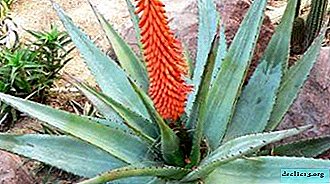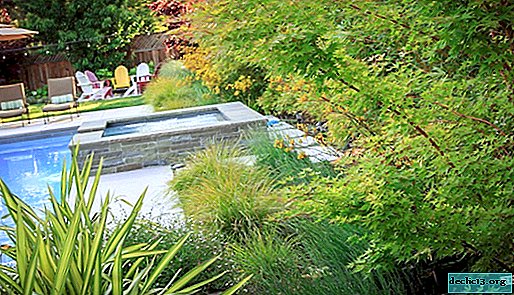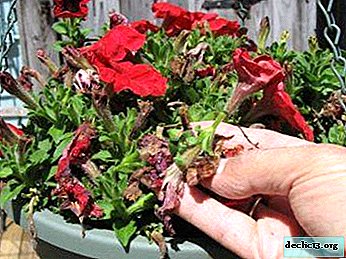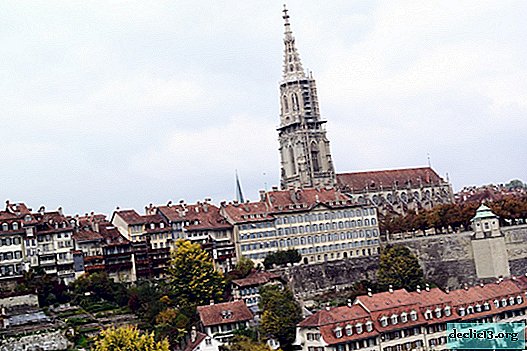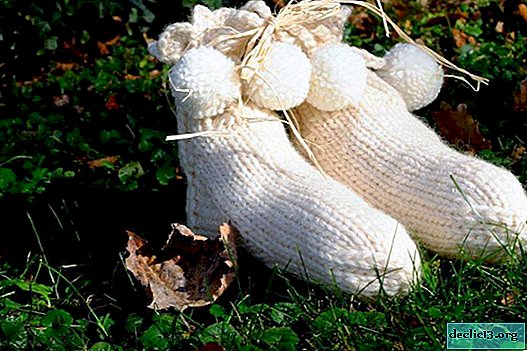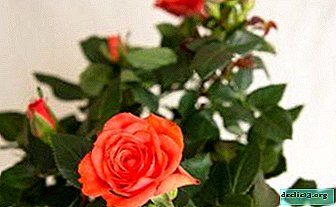Beautiful and useful Caucasian rhododendron - description, photo, care features
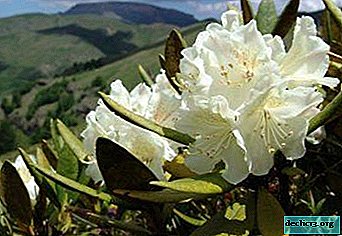
The name of the Caucasian Rhododendron was, in fact, due to the territory of its habitat, because under natural conditions it grows in the Caucasus. This plant is accustomed to difficult conditions, as it is well mastered in the foothills and mountains, it is able to create dense thickets. This wonderful shrub with pleasure is planted in garden plots, because in addition to beauty, the Caucasian Rhododendron has unique medicinal properties, all of which we will discuss in the article.
What is this plant?
This species of Rhododendron belongs to the heather family, it is a shrub with an average height of 60 cm, but sometimes reaches one meter.
Reference! It is also called the Alpine rose due to its unusually beautiful white buds.Detailed description
 Caucasian mountain rhododendron is a small evergreen shrub. with spectacular leaves and gorgeous flowers that compete in beauty with the queen of flowers - the rose.
Caucasian mountain rhododendron is a small evergreen shrub. with spectacular leaves and gorgeous flowers that compete in beauty with the queen of flowers - the rose.
- Leaves it is thick and dense, on top of it the surface is dark green glossy, and below it is grayish-green with a fluff of orange color, the shape of the leaves is elliptical, the tips are pointed.
- Shoots creeping, their bark is dark brown.
- Flowers - white, sometimes they can be yellowish or cream; the form of bells, collected in inflorescences of 10 to 15 pieces, the flowering period occurs at the beginning of summer: June - July.
- Root system - superficial, the roots grow in breadth.
Where does it grow in the wild and how?
Caucasian rhododendron in the wild is well distributed in the highlands of the Caucasus, the largest plantations are found in the mountains of Abkhazia. It grows mainly in continuous dense thickets, spreading rapidly with its seeds.
History of occurrence
This shrub gained fame at the beginning of the 19th century, E. Regel was diligently engaged in its cultivation in the Imperial Botanical Garden (in Russia). But in cultural plantings it spread slowly, because it was rather capricious and whimsical in leaving. And now he is able to take root far from everywhere.
Differences from other species
The main feature of the Caucasian Rhododendron is pure white flowers, and he blooms twice a season - in early summer and autumn - in October.
Healing properties
We still have few such plants where the substances useful for humans are so concentrated, these are:
- essential oils;
- tannins;
- tianins;
- vitamin C;
- beneficial acids.
All parts of the plant possess healing properties: stems, leaves, flowers, and even roots. A lot of diseases are treated by Caucasian rhododendron:
- joint diseases
- heart
- kidneys
- high blood pressure;
- purulent wounds;
- stomatitis and more.
Next, you can watch a video about the healing properties of the Caucasian rodendron:
The most popular are medicinal teas and tinctures from flowers and leaves.
Step-by-step instructions on how to make leaves:
- tea - you need to take 4 dry leaves and pour two glasses of boiling milk, boil all 5 minutes strictly under the lid, you can take it at any time, but no more than three times a day;
- tincture - take 10 g of leaves (you can add the same amount of dried flowers) and pour one glass of vodka, remove to a dark place for 2 weeks, you can take 25 drops (be sure to dilute with water) 3 times a day.
All subgames and their photos
This species has several sub-varieties, which differ in the color of the flowers. You can see their photos below.
Rosea-alba
 Shrub with flowers of a pale pink hue.
Shrub with flowers of a pale pink hue.
Splendens
 This variety has deep pink flowers.. They are collected in small inflorescences.
This variety has deep pink flowers.. They are collected in small inflorescences.
Flavidum
 He has flowers of a juicy yellow color.
He has flowers of a juicy yellow color.
Bloom
The peculiarity of the flowering of the Caucasian Rhododendron is that it occurs in the summer, in June (other varieties bloom in early spring). Flowers are collected in umbrella-shaped inflorescences of 5 to 10 pieces..
How to care at this time?
- Before flowering, you need to carefully monitor the temperature so that the bush does not suffer from late spring frosts, when buds are already formed, before feeding begins to feed.
- If the weather is dry, then be sure to water it.
- And after flowering, it is imperative to remove all the peduncles so as not to weaken the plant, otherwise the seeds will begin to ripen and fertilize as well.
What to do if it does not give buds?
The reason may be in the wrong place of landing (urgently replanted) or in the lack of moisture, you need to adjust the watering.
Use in garden design
Caucasian rhododendron is perfect for decorating the garden, it is often used by designers. It is good to plant a shrub along the northern walls or in a small shade from conifers. But most successfully it is used to design alpine slides.
Advice! Also, planting shrubs on the slopes is a good option - an incredibly beautiful slope is created and at the same time, the shrub perfectly copes with the role of soil cultivator.Step-by-step care instructions
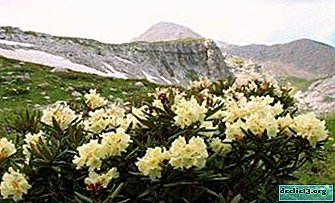 Choosing a landing place - This is a very important moment for the further growth and development of the shrub, because the plant is whimsical, loves sunny places, but not all day. The best place is under the scattered shadow of pine or larch, it is possible under barberry, and this place should not be blown by the winds. It would be very nice to plant a bush next to a pond - a pond, for example.
Choosing a landing place - This is a very important moment for the further growth and development of the shrub, because the plant is whimsical, loves sunny places, but not all day. The best place is under the scattered shadow of pine or larch, it is possible under barberry, and this place should not be blown by the winds. It would be very nice to plant a bush next to a pond - a pond, for example.- Which should be the soil - it should be light, loose, breathable, groundwater should not rise high in it, should not be planted in lowlands.
- Landing - you need to plant a bush in the spring, it is better in the second half of April. At the bottom of the landing pit, drainage is necessarily laid, and then the plant is already planted. After planting, they make a near-stem circle and water it well, and then mulch the surface.
- Temperature - this type of Rhododendron is frost-resistant, able to withstand frosts up to 20 degrees, and the highest temperature for it is 25 degrees heat. The optimum temperature for good development is desirable in the range from 10 frost to 20 degrees Celsius. We wrote about frost-resistant rhododendrons here.
- Watering - the bush needs to be watered in the summer once a week, in spring and autumn it can be less often, depending on the weather. It is undesirable to water tap water, it is best to use river or rain. It is also useful for the bush to periodically spray to create moisture.
- Top dressing - you need to feed the bush 3 times - at the beginning and end of flowering and at the very end of summer, you need to make special balanced fertilizers for Rhododendrons, strictly according to the instructions.
- Pruning - for young bushes (2 years old), pinching is mandatory so that the crown is more magnificent formed, and for adult shrubs only sanitary pruning is required, which is carried out in the fall, while all elongated shoots can be shortened and excess ones removed.
- Transfer - if the bush needs to be transplanted, then it is best done in the early spring, at the end of March or at the very beginning of April, but you can also transplant in the fall - in September, so that the plant has time to grow stronger before winter.
- How to prepare for winter - Caucasian rhododendron needs shelter for the winter, for this you need to build arcs over the shrub and pull lutrasil on them. It is necessary to shelter when the temperature begins to drop below 10 degrees of frost, and to open in the spring, when the soil warms up. And before the onset of frost, the bush needs to be watered well so that the roots are saturated with water.
Propagation Features
This shrub can be propagated in various ways.:
- Layering - Caucasian rhododendron is very successfully propagated by layering, they are easy to tack, because they practically spread along the ground. Layers are dug in the spring, and a year later, next spring, a new plant can be separated and planted in another place.
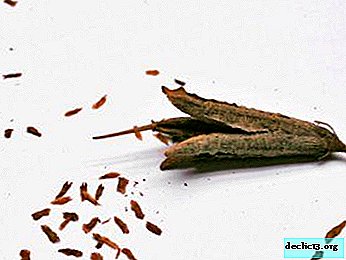 Seeds - You can also propagate it by seeds, this method is used for wild species.
Seeds - You can also propagate it by seeds, this method is used for wild species.- In August we collect ripened seeds.
- We stratify them for 2 months, then soak for 10 hours in Epin's solution.
- Next, we sow them in a substrate (do not bury!), Prepared from peat with sand, create greenhouse conditions.
- After about 10 days (at a temperature of 20 degrees) shoots appear. After 2 weeks you can pick them up.
- And after about a month, planted in separate containers.
- In the spring we plant them in place, such bushes can bloom no earlier than after 3 years.
- Cuttings - cuttings are cut at the beginning of summer (should be 15 cm long), root them in a light substrate and cover with a jar on top, after 1.5 months they will already have their roots.
Diseases and Pests
If the bush is planted on poor, hard soil, then the roots will be damaged very quickly, they will begin to harden and fungal diseases will appear. The plant must be treated with any fungicide and transplanted to the right place.
Important! The most common pest in this shrub is a specific rhododendron bug, it is determined by the multiple bright points on the leaves, insecticide treatment will help here.Prevention of various problems
Naturally, it’s better to prevent any problem than to solve it later. In order to avoid problems with the cultivation of the Caucasian Rhododendron (and it is able to grow and bloom perfectly in one place for at least 30 years), you need to create suitable comfortable conditions for it and take care of it.
Conclusion
Caucasian rhododendron is an unusual plant, it is an excellent ornamental shrub, and a wonderful honey plant, and a wonderful doctor. But not everywhere, unfortunately, it can be settled, it is too selective for conditions. Naturally, gardeners want to plant beautiful and useful shrubs on their plots, but this succeeds in the Moscow and Leningrad regions, as well as in areas that are located above central Russia.

 Choosing a landing place - This is a very important moment for the further growth and development of the shrub, because the plant is whimsical, loves sunny places, but not all day. The best place is under the scattered shadow of pine or larch, it is possible under barberry, and this place should not be blown by the winds. It would be very nice to plant a bush next to a pond - a pond, for example.
Choosing a landing place - This is a very important moment for the further growth and development of the shrub, because the plant is whimsical, loves sunny places, but not all day. The best place is under the scattered shadow of pine or larch, it is possible under barberry, and this place should not be blown by the winds. It would be very nice to plant a bush next to a pond - a pond, for example. Seeds - You can also propagate it by seeds, this method is used for wild species.
Seeds - You can also propagate it by seeds, this method is used for wild species.